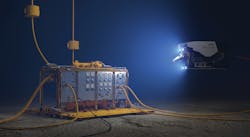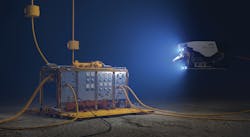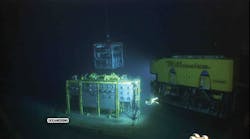Flowline remediation system proves key to deepwater flow assurance campaign
Subsea separator, pumping unit help quickly remove hydrate buildup
Justin Pizzitola
Oceaneering
Oceaneering’s seabed based liquid and gas separation unit also know as the FRS with dual coiled tubing attached. (Images courtesy Oceaneering)
When operators publicly announce projects that include adjectives such as “biggest” and “deepest,” they must also plan for production issues that are likely to occur down the road. Deeper depths can potentially lead to production-critical problems, such as the formation of hydrates that can restrict or completely block production in subsea flowlines.
Hydrate blockages are a notorious problem for deepwater subsea field developments due to the extreme environments in which these developments are operated. Hydrates can form for many reasons, including a high percentage of water cut in aging production assets that leak and ultimately mix water from the environment with production fluids. Other contributing factors include loss of hydrate-inhibiting chemical injection capabilities, damaged umbilicals, or topsides chemical injection pumps that cease working. Successful subsea hydrate remediation can ensure that production is quickly restored.
Oceaneering recently completed a five-month flowline remediation project with four different operators in the US Gulf of Mexico, starting in September 2017. For this campaign, hydrate remediation services were provided to some of the region’s longest and deepest flowlines to date.
The equipment
Oceaneering used a DP-3 multi-purpose service vessel (MPSV) with a deck area of 12,561 sq ft (1,167 sq m), a 400-metric-ton mast crane with active heave compensation, and two of the company’s work-class ROVs.
The MPSV was equipped with the company’s flowline remediation system (FRS). This system included a subsea separator, an emergency quick disconnect (EQD) system, and dual coiled tubing units, as well as a subsea hydraulic power unit (SHPU), a work van, and a control van for the SHPU.
The MPSV was also equipped with a nitrogen spread, along with fluid storage tanks with up to 1,500 bbl capacity, a topsides gas buster, topsides manifolds, chokes, and pressure release valves (PRVs). The package also included water polishing equipment in the event that the project team needed to overboard any type of produced water removed from the line. Two electrical downline (EDL) reels were included for communications to the FRS. The MPSV also carried an intervention skid that was mounted to the bottom of the ROV.
The subsea separator is a mud-mat system that sits as a standalone unit on the seabed, enabling the FRS to separate gas from liquid at the subsea location. It also serves as the interface point for the two coiled tubing strings that plug into it. The SHPU pumps the fluids back to the vessel. The two coiled tubing strings, one for gas and one for liquid, serve as conduits to return gas and liquid to the topsides without any commingling of the separated fluids. The FRS is also capable of chemical injection and dosing.
Oceaneering’s FRS, SHPU, and ROV during deployment and equipment interfacing stage of a campaign.
The EQD system can be controlled topsides. If issues are encountered during the project, such as pressure spikes or the vessel drifting off location, then the project team can trigger the EQD system, which would then close, seal, and eject the coiled tubing lines and the SHPU lines from the FRS.
The FRS ultimately maintains the integrity of the flowline to ensure that fluids are not transferred from the flowline to the environment, and to also ensure that seawater does not seep into the flowline.
The campaign
The goal of the project was to remediate six different flowlines, with pipeline diameters ranging from 6 in. to 8 in., and lengths ranging from 20,000 ft (6,096 m) to 153,000 ft (46,634 m).
During the project, Oceaneering remediated its longest flowline (153,000 ft), along with its deepest flowline [6,400 ft (1,951 m)]. The flowlines involved in the project experienced both pure hydrate blockages and hydrates that were laced with solids and production byproducts, such as sand, asphaltenes, and waxes.
The 153,000-ft flowline was serviced as part of a two-flowline remediation campaign, which ran from Oct. 9 through Nov. 7, 2017. The flowline had a diameter of 8 in., and was located at a depth of 4,300 ft (1,311 m). The flowline experienced a hydrate blockage that contained solids and production byproducts. The longest flowline that Oceaneering had previously remediated measured 121,000 ft (36,881 m) and was also located in the US Gulf of Mexico.
The deepest flowline measured 63,000 ft (19,202 m) long and 6 in. in diameter. It was part of a three-flowline remediation campaign that took place from Nov. 23, 2017, to Jan. 29, 2018. This flowline had a straightforward hydrate blockage without any solids or production byproducts.
The first operator hired the flowline remediation spread from Sept. 14 to Sept. 29, 2017. Upon completion, the vessel transited back to the dock to begin preparations for the next operator’s campaign. The second operator started its project on Oct. 9 and completed it on Nov. 7, 2017. The third operator hired the flowline remediation spread from Nov. 7 to Nov. 21, 2017. The fourth campaign lasted from Nov. 23, 2017, through Jan. 29, 2018. This included approximately 20 days of standby while the project team waited for platform operations to be completed.
The project team used four different interfaces over the course of the five-month project to gain access to the various flowlines. For this campaign, Oceaneering managed up to five different subcontractors on the vessel at any given time.
Challenges
One of the challenges that the team faced included being positioned on the elevated end of a flowline, thus restricting our ability to remove all the fluid from the flowline. The team was able to overcome this by hooking up the flowline remediation system and venting gas to the surface. The team was able to vent enough gas to enable the disassociation from the hydrate without removing all the fluid from the flowline.
Other issues observed during the campaign included the migration of sand and oil byproducts through the system. That issue was successfully mitigated by the strainer that resides in the bottom of our subsea separator.
A typical project duration for a single flowline is 15 to 20 days. The project team encountered pure hydrate blockages on this campaign on all except two flowlines. Those two lines had hydrate blockages mixed with production byproducts that included asphaltenes, waxes, and sand.
The average project time could be extended depending on the byproduct amounts observed within the hydrates. The byproduct amounts found within the hydrates on this campaign were minimal and, therefore, did not have a significant effect on project duration.
Results
Oceaneering used a dedicated team throughout the campaign to oversee hydrate remediation services for four different operators. A metric of 98% uptime was achieved due to implementation of previous lessons learned.
The individual projects of this five-month campaign were completed on average between 15 and 20 days in operation. Using the subsea separator and active subsea pumping can reduce overall remediation time when compared to other hydrate remediation techniques. •


